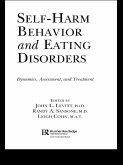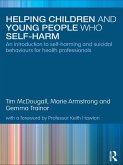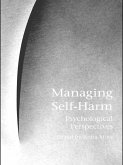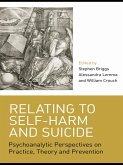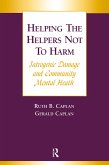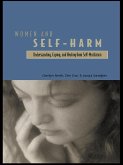26,95 €
26,95 €
inkl. MwSt.
Sofort per Download lieferbar

13 °P sammeln
26,95 €
Als Download kaufen

26,95 €
inkl. MwSt.
Sofort per Download lieferbar

13 °P sammeln
Jetzt verschenken
Alle Infos zum eBook verschenken
26,95 €
inkl. MwSt.
Sofort per Download lieferbar
Alle Infos zum eBook verschenken

13 °P sammeln
- Format: PDF
- Merkliste
- Auf die Merkliste
- Bewerten Bewerten
- Teilen
- Produkt teilen
- Produkterinnerung
- Produkterinnerung

Bitte loggen Sie sich zunächst in Ihr Kundenkonto ein oder registrieren Sie sich bei
bücher.de, um das eBook-Abo tolino select nutzen zu können.
Hier können Sie sich einloggen
Hier können Sie sich einloggen
Sie sind bereits eingeloggt. Klicken Sie auf 2. tolino select Abo, um fortzufahren.

Bitte loggen Sie sich zunächst in Ihr Kundenkonto ein oder registrieren Sie sich bei bücher.de, um das eBook-Abo tolino select nutzen zu können.
Life After Self-Harm: A Guide to the Future is written for individuals who have deliberately harmed themselves. Developed through a major research project the contents of the manual have been informed and shaped by many users and expert
- Geräte: PC
- mit Kopierschutz
- eBook Hilfe
- Größe: 1.88MB
Andere Kunden interessierten sich auch für
![Self-Harm Behavior and Eating Disorders (eBook, PDF) Self-Harm Behavior and Eating Disorders (eBook, PDF)]() Self-Harm Behavior and Eating Disorders (eBook, PDF)46,95 €
Self-Harm Behavior and Eating Disorders (eBook, PDF)46,95 €![Helping Children and Young People who Self-harm (eBook, PDF) Helping Children and Young People who Self-harm (eBook, PDF)]() Tim McdougallHelping Children and Young People who Self-harm (eBook, PDF)33,95 €
Tim McdougallHelping Children and Young People who Self-harm (eBook, PDF)33,95 €![Managing Self-Harm (eBook, PDF) Managing Self-Harm (eBook, PDF)]() Managing Self-Harm (eBook, PDF)37,95 €
Managing Self-Harm (eBook, PDF)37,95 €![Relating to Self-Harm and Suicide (eBook, PDF) Relating to Self-Harm and Suicide (eBook, PDF)]() Relating to Self-Harm and Suicide (eBook, PDF)37,95 €
Relating to Self-Harm and Suicide (eBook, PDF)37,95 €![Helping the Helpers Not to Harm (eBook, PDF) Helping the Helpers Not to Harm (eBook, PDF)]() Gerald CaplanHelping the Helpers Not to Harm (eBook, PDF)54,95 €
Gerald CaplanHelping the Helpers Not to Harm (eBook, PDF)54,95 €![The Aesthetics of Self-Harm (eBook, PDF) The Aesthetics of Self-Harm (eBook, PDF)]() Zoe AldertonThe Aesthetics of Self-Harm (eBook, PDF)43,95 €
Zoe AldertonThe Aesthetics of Self-Harm (eBook, PDF)43,95 €![Women and Self Harm (eBook, PDF) Women and Self Harm (eBook, PDF)]() Gerrilyn SmithWomen and Self Harm (eBook, PDF)20,95 €
Gerrilyn SmithWomen and Self Harm (eBook, PDF)20,95 €-
-
-
Life After Self-Harm: A Guide to the Future is written for individuals who have deliberately harmed themselves. Developed through a major research project the contents of the manual have been informed and shaped by many users and expert
Dieser Download kann aus rechtlichen Gründen nur mit Rechnungsadresse in A, B, BG, CY, CZ, D, DK, EW, E, FIN, F, GR, HR, H, IRL, I, LT, L, LR, M, NL, PL, P, R, S, SLO, SK ausgeliefert werden.
Produktdetails
- Produktdetails
- Verlag: Taylor & Francis eBooks
- Seitenzahl: 120
- Erscheinungstermin: 1. März 2004
- Englisch
- ISBN-13: 9781135446833
- Artikelnr.: 38403100
- Verlag: Taylor & Francis eBooks
- Seitenzahl: 120
- Erscheinungstermin: 1. März 2004
- Englisch
- ISBN-13: 9781135446833
- Artikelnr.: 38403100
- Herstellerkennzeichnung Die Herstellerinformationen sind derzeit nicht verfügbar.
Ulrike Schmidt is a Consultant Psychiatrist at the Maudsley Hospital and Senior Lecturer at the Institute of Psychiatry, London.
Kate Davidson is a Consultant Clinical Psychologist in Greater Glasgow Primary Care NHS Trust. She is currently Director of the Glasgow Institute of Psychosocial Interventions.
Kate Davidson is a Consultant Clinical Psychologist in Greater Glasgow Primary Care NHS Trust. She is currently Director of the Glasgow Institute of Psychosocial Interventions.
Major Health Warning. Note to Health Care Practitioner. Part I: Getting
Started. Introduction. You are Not Alone. Why do People Harm Themselves?
Trying to Understand Your Reasons for Harming Yourself. Is There Anybody
Out There? Further Thoughts. What Next? Part II: What to Do in a Crisis.
Getting Support. Keeping Yourself Safe. Trying Not to Slide Down into a Pit
of Loneliness and Despair. Things I Still Want to Do. Crisis Plan. Part
III: Learning to Solve Problems. Help! My Life is a Mess. Learning to
Disentangle Your Problems. Step 1: Finding Possible Solutions Through
Brainstorming. Step 2: Looking at Options in Detail. Step 3: Choosing a
Solution that Fits You. Step 4: Finding Ways of Putting Your Solution into
Practice. Step 5: Carry Out Your Plan Step by Step. Step 6: Check Progress
in Problem Solving. Part IV: Learning to Change Your Thinking. Let's Make a
Start by Looking at Moods. Linking Feelings and Thoughts. A Thought is Not
a Fact: Learn to Recognize Skewed Thinking. Where Does This Kind of Skewed
Thinking Come From? The Memory Trap or: Why Does my Thinking Overwhelm Me?
Starting a Thought Record. How to Challenge Biased Thinking. Part V:
Alcohol, Drugs and Pills: Do You Need to Cut Down or Stop? Should You be
Worried About Your Alcohol Intake? Have the Guts to Stop or Cut Down
Drinking. Should You be Worried About Your Drug Intake? Should You be
Worried About Your Consumption of Tranquillizers or Sleeping Tablets? How
to Deal with Sleeping Difficulties. Part VI: Some Further Thoughts. What
Can You Learn From the Past? What if You Found Yourself Slipping Again? "If
Only..." From Change to Accepting. What Cannot be Changed.
Started. Introduction. You are Not Alone. Why do People Harm Themselves?
Trying to Understand Your Reasons for Harming Yourself. Is There Anybody
Out There? Further Thoughts. What Next? Part II: What to Do in a Crisis.
Getting Support. Keeping Yourself Safe. Trying Not to Slide Down into a Pit
of Loneliness and Despair. Things I Still Want to Do. Crisis Plan. Part
III: Learning to Solve Problems. Help! My Life is a Mess. Learning to
Disentangle Your Problems. Step 1: Finding Possible Solutions Through
Brainstorming. Step 2: Looking at Options in Detail. Step 3: Choosing a
Solution that Fits You. Step 4: Finding Ways of Putting Your Solution into
Practice. Step 5: Carry Out Your Plan Step by Step. Step 6: Check Progress
in Problem Solving. Part IV: Learning to Change Your Thinking. Let's Make a
Start by Looking at Moods. Linking Feelings and Thoughts. A Thought is Not
a Fact: Learn to Recognize Skewed Thinking. Where Does This Kind of Skewed
Thinking Come From? The Memory Trap or: Why Does my Thinking Overwhelm Me?
Starting a Thought Record. How to Challenge Biased Thinking. Part V:
Alcohol, Drugs and Pills: Do You Need to Cut Down or Stop? Should You be
Worried About Your Alcohol Intake? Have the Guts to Stop or Cut Down
Drinking. Should You be Worried About Your Drug Intake? Should You be
Worried About Your Consumption of Tranquillizers or Sleeping Tablets? How
to Deal with Sleeping Difficulties. Part VI: Some Further Thoughts. What
Can You Learn From the Past? What if You Found Yourself Slipping Again? "If
Only..." From Change to Accepting. What Cannot be Changed.
Major Health Warning. Note to Health Care Practitioner. Part I: Getting
Started. Introduction. You are Not Alone. Why do People Harm Themselves?
Trying to Understand Your Reasons for Harming Yourself. Is There Anybody
Out There? Further Thoughts. What Next? Part II: What to Do in a Crisis.
Getting Support. Keeping Yourself Safe. Trying Not to Slide Down into a Pit
of Loneliness and Despair. Things I Still Want to Do. Crisis Plan. Part
III: Learning to Solve Problems. Help! My Life is a Mess. Learning to
Disentangle Your Problems. Step 1: Finding Possible Solutions Through
Brainstorming. Step 2: Looking at Options in Detail. Step 3: Choosing a
Solution that Fits You. Step 4: Finding Ways of Putting Your Solution into
Practice. Step 5: Carry Out Your Plan Step by Step. Step 6: Check Progress
in Problem Solving. Part IV: Learning to Change Your Thinking. Let's Make a
Start by Looking at Moods. Linking Feelings and Thoughts. A Thought is Not
a Fact: Learn to Recognize Skewed Thinking. Where Does This Kind of Skewed
Thinking Come From? The Memory Trap or: Why Does my Thinking Overwhelm Me?
Starting a Thought Record. How to Challenge Biased Thinking. Part V:
Alcohol, Drugs and Pills: Do You Need to Cut Down or Stop? Should You be
Worried About Your Alcohol Intake? Have the Guts to Stop or Cut Down
Drinking. Should You be Worried About Your Drug Intake? Should You be
Worried About Your Consumption of Tranquillizers or Sleeping Tablets? How
to Deal with Sleeping Difficulties. Part VI: Some Further Thoughts. What
Can You Learn From the Past? What if You Found Yourself Slipping Again? "If
Only..." From Change to Accepting. What Cannot be Changed.
Started. Introduction. You are Not Alone. Why do People Harm Themselves?
Trying to Understand Your Reasons for Harming Yourself. Is There Anybody
Out There? Further Thoughts. What Next? Part II: What to Do in a Crisis.
Getting Support. Keeping Yourself Safe. Trying Not to Slide Down into a Pit
of Loneliness and Despair. Things I Still Want to Do. Crisis Plan. Part
III: Learning to Solve Problems. Help! My Life is a Mess. Learning to
Disentangle Your Problems. Step 1: Finding Possible Solutions Through
Brainstorming. Step 2: Looking at Options in Detail. Step 3: Choosing a
Solution that Fits You. Step 4: Finding Ways of Putting Your Solution into
Practice. Step 5: Carry Out Your Plan Step by Step. Step 6: Check Progress
in Problem Solving. Part IV: Learning to Change Your Thinking. Let's Make a
Start by Looking at Moods. Linking Feelings and Thoughts. A Thought is Not
a Fact: Learn to Recognize Skewed Thinking. Where Does This Kind of Skewed
Thinking Come From? The Memory Trap or: Why Does my Thinking Overwhelm Me?
Starting a Thought Record. How to Challenge Biased Thinking. Part V:
Alcohol, Drugs and Pills: Do You Need to Cut Down or Stop? Should You be
Worried About Your Alcohol Intake? Have the Guts to Stop or Cut Down
Drinking. Should You be Worried About Your Drug Intake? Should You be
Worried About Your Consumption of Tranquillizers or Sleeping Tablets? How
to Deal with Sleeping Difficulties. Part VI: Some Further Thoughts. What
Can You Learn From the Past? What if You Found Yourself Slipping Again? "If
Only..." From Change to Accepting. What Cannot be Changed.

